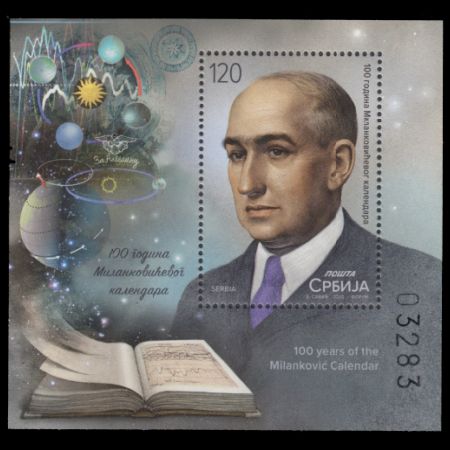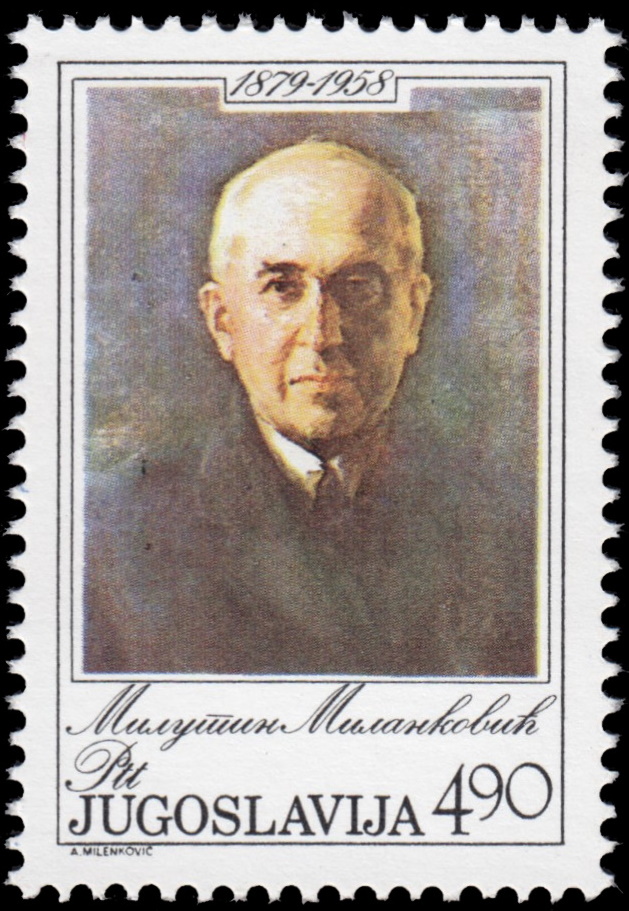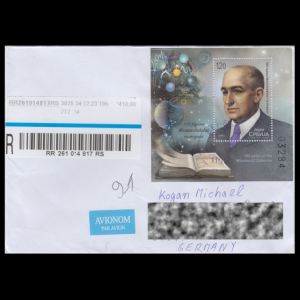Serbia 2023 "100 years of the Milankovich calendar"
| << previous | back to index | next >> |
| Issue Date | 21.11.2023 |
| ID | Michel: , Scott: , Category: Ot |
| Design | artist: Boban Savich consultant: Svetozar Markovich from University Library in Belgrade |
| Stamps in set | 1 |
| Value | RSD120 - Astronomer: Milutin Milankovich |
| Emission/Type | commemorative |
| Issue place | Belgrade (Beograd) |
| Size (width x height) | stamp: 35mm x 49.5mm, Souvenir-Sheet: 85mm x 80mm |
| Layout | Souvenir-Sheet of 1 stamp |
| Products | FDC x1 |
| Paper | |
| Perforation | |
| Print Technique | Offset, lithography |
| Printed by | Forum |
| Quantity | 10.000 |
| Issuing Authority | Serbian Post |

On November 21st, 2023, the Post Authority of Serbia issued the Souvenir-Sheet "100 years of the Milankovich calendar".
 |
| The first stamp of Milutin Milankovich was issued in Yugoslavia in 1979 to commemorate his 100 anniversary, MiNr.: 1793, Scott: 1432. |
Milutin Milankovich (Dalj, May 28, 1879 – Belgrade, December 12, 1958) was a civil engineer,
mathematician, astronomer, climatologist and popularizer of science.
Full professor of celestial mechanics, dean of the Faculty of Philosophy, director of the Astronomical
Observatory in Belgrade and vice president of SASA, he was remembered in the history of science,
first of all, for his theory about changes in the Earth's climate over a long period of time,
known as Milankovich cycles, as well as the reform of the Julian calendar.
Rejecting a very lucrative career as a construction engineer in Vienna, Milankovich came to
Belgrade on a modest salary as a university professor for patriotic reasons and out of love for science.
He is our greatest scientist who built his career in Serbia.
The reform of the Julian calendar, proposed by Milutin Milankovich in 1923, is based on the
idea of abolishing the date difference between the Julian and Gregorian calendars, as well as
calculating leap years in the future in a specific way that ensures much greater precision of this calendar
compared to the Gregorian one.
Based on very complex mathematical calculations, Milankovich proposed the most accurate calendar up to that time,
which has not been surpassed to this day.
Milankovich 's scientific work on the theory of climate change and the alignment of the calendar with astronomical
events speak best of his commitment to science and precision in the study of astronomical and climatic changes over
long time intervals.
Milankovitch's works on astronomical explanations of ice ages, especially his curve of insolation for the past 130,000 years, received support from the climatologist Wladimir Köppen and from the geophysicist Alfred Wegener. Köppen noted the usefulness of Milankovitch's theory for paleoclimatological researchers. Milankovitch received a letter on 22 September 1922 from Köppen, who asked him to expand his studies from 130,000 years to 600,000 years.
Products and associated philatelic items
| FDC | Example of Circulated Cover | |
 |
 |
|
References:
- [R1] Technical details: Colnect.
- [R2] Milutin Milankovich: reverse side of official FDC, Wikipedia.
Acknowledgements:
Many thanks to Dr. Peter Voice from Department of Geological and Environmental Sciences, Western Michigan University, for the draft page review and his very valuable comments.
| << previous | back to index | next >> |